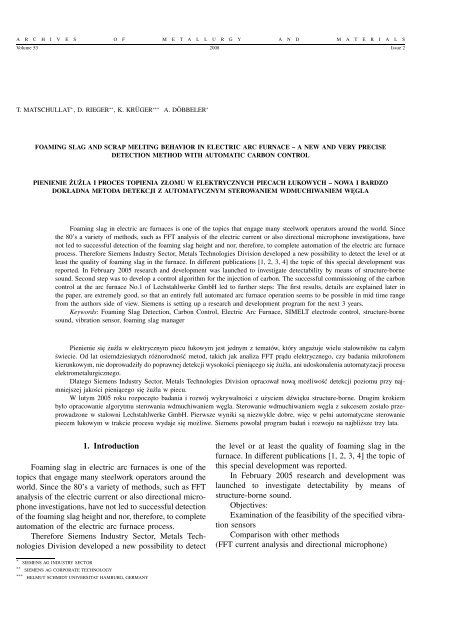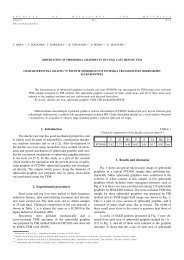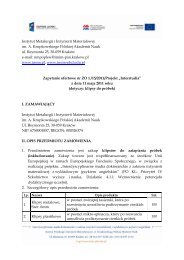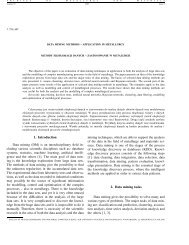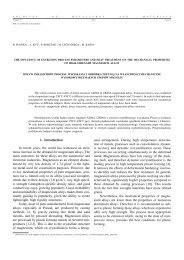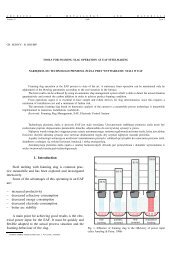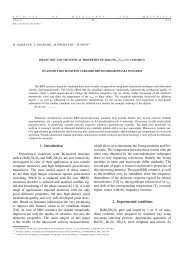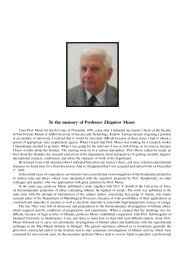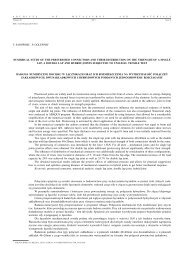1. Introduction Foaming slag in electric arc furnaces is one of the ...
1. Introduction Foaming slag in electric arc furnaces is one of the ...
1. Introduction Foaming slag in electric arc furnaces is one of the ...
Create successful ePaper yourself
Turn your PDF publications into a flip-book with our unique Google optimized e-Paper software.
A R C H I V E S O F M E T A L L U R G Y A N D M A T E R I A L S<br />
Volume 53 2008 Issue 2<br />
T. MATSCHULLAT ∗ , D. RIEGER ∗∗ , K. KRÜGER ∗∗∗ A. DÖBBELER ∗<br />
FOAMING SLAG AND SCRAP MELTING BEHAVIOR IN ELECTRIC ARC FURNACE – A NEW AND VERY PRECISE<br />
DETECTION METHOD WITH AUTOMATIC CARBON CONTROL<br />
PIENIENIE ŻUŻLA I PROCES TOPIENIA ZŁOMU W ELEKTRYCZNYCH PIECACH ŁUKOWYCH – NOWA I BARDZO<br />
DOKŁADNA METODA DETEKCJI Z AUTOMATYCZNYM STEROWANIEM WDMUCHIWANIEM WĘGLA<br />
<strong>Foam<strong>in</strong>g</strong> <strong>slag</strong> <strong>in</strong> <strong>electric</strong> <strong>arc</strong> <strong>furnaces</strong> <strong>is</strong> <strong>one</strong> <strong>of</strong> <strong>the</strong> topics that engage many steelwork operators around <strong>the</strong> world. S<strong>in</strong>ce<br />
<strong>the</strong> 80’s a variety <strong>of</strong> methods, such as FFT analys<strong>is</strong> <strong>of</strong> <strong>the</strong> <strong>electric</strong> current or also directional microph<strong>one</strong> <strong>in</strong>vestigations, have<br />
not led to successful detection <strong>of</strong> <strong>the</strong> foam<strong>in</strong>g <strong>slag</strong> height and nor, <strong>the</strong>refore, to complete automation <strong>of</strong> <strong>the</strong> <strong>electric</strong> <strong>arc</strong> furnace<br />
process. Therefore Siemens Industry Sector, Metals Technologies Div<strong>is</strong>ion developed a new possibility to detect <strong>the</strong> level or at<br />
least <strong>the</strong> quality <strong>of</strong> foam<strong>in</strong>g <strong>slag</strong> <strong>in</strong> <strong>the</strong> furnace. In different publications [1, 2, 3, 4] <strong>the</strong> topic <strong>of</strong> th<strong>is</strong> special development was<br />
reported. In February 2005 rese<strong>arc</strong>h and development was launched to <strong>in</strong>vestigate detectability by means <strong>of</strong> structure-borne<br />
sound. Second step was to develop a control algorithm for <strong>the</strong> <strong>in</strong>jection <strong>of</strong> carbon. The successful comm<strong>is</strong>sion<strong>in</strong>g <strong>of</strong> <strong>the</strong> carbon<br />
control at <strong>the</strong> <strong>arc</strong> furnace No.1 <strong>of</strong> Lechstahlwerke GmbH led to fur<strong>the</strong>r steps: The first results, details are expla<strong>in</strong>ed later <strong>in</strong><br />
<strong>the</strong> paper, are extremely good, so that an entirely full automated <strong>arc</strong> furnace operation seems to be possible <strong>in</strong> mid time range<br />
from <strong>the</strong> authors side <strong>of</strong> view. Siemens <strong>is</strong> sett<strong>in</strong>g up a rese<strong>arc</strong>h and development program for <strong>the</strong> next 3 years.<br />
Keywords: <strong>Foam<strong>in</strong>g</strong> Slag Detection, Carbon Control, Electric Arc Furnace, SIMELT electrode control, structure-borne<br />
sound, vibration sensor, foam<strong>in</strong>g <strong>slag</strong> manager<br />
Pienienie się żużla w elektrycznym piecu łukowym jest jednym z tematów, który angażuje wielu stalowników na całym<br />
świecie. Od lat osiemdziesiątych różnorodność metod, takich jak analiza FFT prądu elektrycznego, czy badania mikr<strong>of</strong><strong>one</strong>m<br />
kierunkowym, nie doprowadziły do poprawnej detekcji wysokości pieniącego się żużla, ani udoskonalenia automatyzacji procesu<br />
elektrometalurgicznego.<br />
Dlatego Siemens Industry Sector, Metals Technologies Div<strong>is</strong>ion opracował nową możliwość detekcji poziomu przy najmniejszej<br />
jakości pieniącego się żużla w piecu.<br />
W lutym 2005 roku rozpoczęto badania i rozwój wykrywalności z użyciem dźwięku structure-borne. Drugim krokiem<br />
było opracowanie algorytmu sterowania wdmuchiwaniem węgla. Sterowanie wdmuchiwaniem węgla z sukcesem zostało przeprowadz<strong>one</strong><br />
w stalowni Lechstahlwerke GmbH. Pierwsze wyniki są niezwykle dobre, więc w pełni automatyczne sterowanie<br />
piecem łukowym w trakcie procesu wydaje się możliwe. Siemens powołał program badań i rozwoju na najbliższe trzy lata.<br />
<strong>1.</strong> <strong>Introduction</strong><br />
<strong>Foam<strong>in</strong>g</strong> <strong>slag</strong> <strong>in</strong> <strong>electric</strong> <strong>arc</strong> <strong>furnaces</strong> <strong>is</strong> <strong>one</strong> <strong>of</strong> <strong>the</strong><br />
topics that engage many steelwork operators around <strong>the</strong><br />
world. S<strong>in</strong>ce <strong>the</strong> 80’s a variety <strong>of</strong> methods, such as FFT<br />
analys<strong>is</strong> <strong>of</strong> <strong>the</strong> <strong>electric</strong> current or also directional microph<strong>one</strong><br />
<strong>in</strong>vestigations, have not led to successful detection<br />
<strong>of</strong> <strong>the</strong> foam<strong>in</strong>g <strong>slag</strong> height and nor, <strong>the</strong>refore, to complete<br />
automation <strong>of</strong> <strong>the</strong> <strong>electric</strong> <strong>arc</strong> furnace process.<br />
Therefore Siemens Industry Sector, Metals Technologies<br />
Div<strong>is</strong>ion developed a new possibility to detect<br />
<strong>the</strong> level or at least <strong>the</strong> quality <strong>of</strong> foam<strong>in</strong>g <strong>slag</strong> <strong>in</strong> <strong>the</strong><br />
furnace. In different publications [1, 2, 3, 4] <strong>the</strong> topic <strong>of</strong><br />
th<strong>is</strong> special development was reported.<br />
In February 2005 rese<strong>arc</strong>h and development was<br />
launched to <strong>in</strong>vestigate detectability by means <strong>of</strong><br />
structure-borne sound.<br />
Objectives:<br />
Exam<strong>in</strong>ation <strong>of</strong> <strong>the</strong> feasibility <strong>of</strong> <strong>the</strong> specified vibration<br />
sensors<br />
Compar<strong>is</strong>on with o<strong>the</strong>r methods<br />
(FFT current analys<strong>is</strong> and directional microph<strong>one</strong>)<br />
∗ SIEMENS AG INDUSTRY SECTOR<br />
∗∗ SIEMENS AG CORPORATE TECHNOLOGY<br />
∗∗∗ HELMUT SCHMIDT UNIVERSITAT HAMBURG, GERMANY
400<br />
Second step was to develop a control algorithm for <strong>the</strong><br />
<strong>in</strong>jection <strong>of</strong> carbon.<br />
Objectives:<br />
Carbon – control algorithm for different valve types<br />
Optimization function with fuzzy logic<br />
Independent carbon <strong>in</strong>put over 3 valves<br />
The successful comm<strong>is</strong>sion<strong>in</strong>g <strong>of</strong> <strong>the</strong> carbon control at<br />
<strong>the</strong> <strong>arc</strong> furnace No.1 <strong>of</strong> Lechstahlwerke GmbH led to<br />
fur<strong>the</strong>r steps:<br />
Objectives:<br />
Diagnos<strong>is</strong> <strong>of</strong> scrap type <strong>in</strong> <strong>the</strong> furnace<br />
Diagnos<strong>is</strong> <strong>of</strong> melt<strong>in</strong>g down behavior<br />
Determ<strong>in</strong>ation <strong>of</strong> s<strong>in</strong>gular effects (e.g. scrap cave <strong>in</strong>)<br />
The first results, details are expla<strong>in</strong>ed later <strong>in</strong> <strong>the</strong> paper,<br />
are extremely good, so that an entirely full automated<br />
<strong>arc</strong> furnace operation seems to be possible <strong>in</strong> mid time<br />
range from <strong>the</strong> authors side <strong>of</strong> view. Siemens <strong>is</strong> sett<strong>in</strong>g<br />
up a rese<strong>arc</strong>h and development program for <strong>the</strong> next 3<br />
years.<br />
Installation <strong>of</strong> SIMELT FSM at EAF No.1 <strong>of</strong> LSW<br />
Current signal<br />
(Voltage signal)<br />
Carbon <strong>in</strong>jection, O 2 ,<br />
Control<br />
signal<br />
„<strong>slag</strong> height“<br />
Control room<br />
Signal aqcu<strong>is</strong>ition<br />
Calculation<br />
Furnace PLC<br />
˜<br />
Captur<strong>in</strong>g <strong>of</strong> signals<br />
High current system<br />
Structural sound<br />
Sensor 3<br />
Fiber optic cable (100 m)<br />
Electrodes<br />
Furnace vessel<br />
Protected cabl<strong>in</strong>g<br />
double screened<br />
Structural sound<br />
Sensor 2<br />
amplifier / optical converter<br />
page 1 9 th European Electric Steelmak<strong>in</strong>g Conference – KrakowPoland – May 2008 Dr. Matschullat, Dr. Rieger © Siemens AG<br />
Fig. <strong>1.</strong> Installation <strong>of</strong> SIMELT FSM at <strong>arc</strong> furnace No.1 <strong>of</strong> Lechstahl<br />
It can be seen that a total <strong>of</strong> 3 sensors <strong>is</strong> used. Vibration<br />
sensors were attached to <strong>the</strong> furnace panel opposite<br />
to <strong>the</strong> three electrodes, with an adapter plate hav<strong>in</strong>g been<br />
welded to <strong>the</strong> panel. On <strong>the</strong> next figure <strong>one</strong> can see an<br />
example for <strong>the</strong> actual <strong>in</strong>stallation <strong>of</strong> a s<strong>in</strong>gle sensor.<br />
2. Technical partner Lechstahlwerke GmbH<br />
The technical partner <strong>in</strong> <strong>the</strong> program, as menti<strong>one</strong>d<br />
<strong>in</strong> chapter 1, <strong>is</strong> Lechstahlwerke GmbH <strong>in</strong> <strong>the</strong> south <strong>of</strong><br />
Germany near Munich. Lechstahl operates 2 <strong>arc</strong> <strong>furnaces</strong><br />
with a tapp<strong>in</strong>g weight <strong>of</strong> 100 mt, 2 ladle <strong>furnaces</strong>, <strong>one</strong><br />
VD plant, two 4 strand billet caster, and beside <strong>the</strong> melt<br />
shop also a roll<strong>in</strong>g mill.<br />
The foam<strong>in</strong>g <strong>slag</strong> detection and carbon control unit<br />
<strong>is</strong> <strong>in</strong>stalled at <strong>arc</strong> furnace No. 1<br />
Description <strong>of</strong> <strong>the</strong> character<strong>is</strong>tic data:<br />
Sensor mounted on furnace panel;<br />
actual situation at LSW Furnace No.1<br />
Sensor mounted <strong>in</strong> an area<br />
with ability to vibrate<br />
High temperature cable<br />
High shielded<br />
page 2 9 th European Electric Steelmak<strong>in</strong>g Conference – Krakow Poland – May 2008 Dr. Matschullat, Dr. Rieger © Siemens AG<br />
⇒ Product mix: 80% re<strong>in</strong>forc<strong>in</strong>g bars, 20% SBQ grades<br />
⇒ Average 73 m<strong>in</strong>. tap to tap time<br />
⇒ Tapp<strong>in</strong>g weight 100 mt<br />
⇒ 3 bucket operation<br />
⇒ Capacity <strong>of</strong> <strong>arc</strong> furnace transformer: 75 MVA<br />
⇒ Dynamic compensation plant (SVC)<br />
⇒ Burner system with multi-po<strong>in</strong>t carbon <strong>in</strong>jection<br />
⇒ Siemens SIMETAL CIS SIMELT electrode control<br />
system.<br />
3. <strong>Foam<strong>in</strong>g</strong> Slag Manager <strong>in</strong>stallation at <strong>arc</strong><br />
furnace No. 1<br />
The <strong>in</strong>stallation <strong>of</strong> <strong>the</strong> foam<strong>in</strong>g <strong>slag</strong> detection and<br />
carbon control unit looks like th<strong>is</strong>:<br />
Fig. 2. Example for sensor mount<strong>in</strong>g on furnace panel<br />
In addition to <strong>the</strong> measur<strong>in</strong>g <strong>in</strong>struments shown on<br />
<strong>the</strong> previous slide, <strong>the</strong> current signal <strong>of</strong> <strong>the</strong> SIMETAL CIS<br />
SIMELT AC closed-loop electrode control system was<br />
also picked up <strong>in</strong> order to be able to <strong>in</strong>vestigate <strong>the</strong> FFT<br />
method as well, which <strong>is</strong> <strong>the</strong> usual method on <strong>the</strong> market<br />
at present.<br />
The <strong>electric</strong> <strong>arc</strong> serves as <strong>the</strong> acoustic source for determ<strong>in</strong><strong>in</strong>g<br />
<strong>the</strong> height <strong>of</strong> <strong>the</strong> foam<strong>in</strong>g <strong>slag</strong>. As <strong>the</strong> generation<br />
<strong>of</strong> <strong>the</strong> sound cannot be measured at its source itself,<br />
<strong>the</strong> current signal <strong>is</strong> used as a reference signal for <strong>the</strong><br />
subsequent evaluations. The signal at <strong>the</strong> furnace wall <strong>is</strong><br />
<strong>the</strong>n noth<strong>in</strong>g o<strong>the</strong>r than <strong>the</strong> weaken<strong>in</strong>g <strong>of</strong> <strong>the</strong> generated<br />
signal, which ultimately <strong>is</strong> equivalent to attenuation. The<br />
attenuation depends on <strong>the</strong> foam<strong>in</strong>g <strong>slag</strong> height, as <strong>the</strong><br />
vibration transm<strong>is</strong>sion path ma<strong>in</strong>ly passes through <strong>the</strong><br />
steel phase and only to a m<strong>in</strong>or extent via <strong>the</strong> gas phase.
401<br />
4. Control concept and development results<br />
The sole detection <strong>of</strong> foam<strong>in</strong>g <strong>slag</strong> level <strong>in</strong> <strong>the</strong> <strong>arc</strong><br />
furnace <strong>is</strong> o.k. for <strong>the</strong> means <strong>of</strong> process diagnos<strong>is</strong>, but not<br />
sat<strong>is</strong>fy<strong>in</strong>g for <strong>the</strong> control <strong>of</strong> <strong>the</strong> carbon <strong>in</strong>jection phase.<br />
Siemens developed a control system with two different<br />
algorithms. One as I-Controller with flexible adjustment,<br />
<strong>the</strong> o<strong>the</strong>r for simple <strong>in</strong>jection carbon valves as fuzzy controller.<br />
The last led to a pulsed width method for carbon<br />
control.<br />
Each carbon valve <strong>is</strong> controlled <strong>in</strong>dividually from<br />
<strong>the</strong> related level <strong>of</strong> <strong>slag</strong> <strong>in</strong> <strong>the</strong> referr<strong>in</strong>g region <strong>of</strong> <strong>the</strong><br />
furnace.<br />
which <strong>is</strong> very important for different steel grades and for<br />
different furnace situations like cold furnace, new l<strong>in</strong><strong>in</strong>g<br />
etc.<br />
As start<strong>in</strong>g po<strong>in</strong>t for <strong>the</strong> full automatic start <strong>of</strong> <strong>the</strong><br />
carbon control <strong>the</strong> related value <strong>of</strong> entire <strong>electric</strong>al energy<br />
to <strong>the</strong> entire charged material can be used, as specific<br />
value <strong>in</strong> case <strong>of</strong> Level 2 system <strong>is</strong> <strong>in</strong> use or as total<br />
energy value if only Level 1 <strong>is</strong> available. In <strong>the</strong> figure 5<br />
<strong>one</strong> can see <strong>the</strong> behavior <strong>of</strong> <strong>slag</strong> signal versus <strong>electric</strong>al<br />
energy. In nearly each case all 3 signals start to <strong>in</strong>crease<br />
at <strong>the</strong> same energy level, which <strong>is</strong> described as energy<br />
threshold <strong>in</strong> figure 6.<br />
target:<br />
Uniform <strong>slag</strong> level<br />
In all 3 regions<br />
Reference<br />
Slag height<br />
Control Concept<br />
normed<br />
deviation<br />
(+/- 1)<br />
+ -<br />
4 5<br />
4 0<br />
3 5<br />
3 0<br />
2 5<br />
2 0<br />
1 5<br />
1 0<br />
5<br />
0<br />
11 20 12 20 13 20 142 0<br />
Procedure:<br />
Control <strong>of</strong> 3 carbon valves<br />
Beg<strong>in</strong> <strong>of</strong> foam<strong>in</strong>g lagged<br />
by 15-20 s<br />
FUZZY Controller<br />
• def<strong>in</strong>ed rules<br />
• prediction 10 s<br />
• variabel Ga<strong>in</strong><br />
I-Controler<br />
• flexibel adjustment<br />
C1, C2, C3<br />
Slag sensors 1, 2, 3<br />
page 3 9 th European Electric Steelmak<strong>in</strong>g Conference – Krakow Poland – May 2008 Dr. Matschullat, Dr. Rieger © Siemens AG<br />
Fig. 3. Control concept for <strong>in</strong>jection carbon<br />
Ks1<br />
Ks2<br />
Ks3<br />
Sensor1<br />
C2<br />
Jet 2<br />
model: <strong>slag</strong> foam<strong>in</strong>g<br />
reaktion by C<br />
(Convolution, time delay)<br />
1<br />
Sensor 2<br />
Jet 3<br />
Slag height<br />
+ -<br />
2<br />
3<br />
d<strong>is</strong>turbance<br />
<strong>in</strong>ternal reaction<br />
The next figure shows <strong>the</strong> possibilities <strong>of</strong> different<br />
phases <strong>in</strong> <strong>the</strong> process <strong>of</strong> blow<strong>in</strong>g carbon <strong>in</strong>to <strong>the</strong> furnace<br />
C 1<br />
Jet 1<br />
Sensor3<br />
Slagdoor<br />
C 3<br />
Körper-Schlackensignal<br />
Slag Slag signal versus Energy <strong>in</strong> kWh<br />
40<br />
35<br />
30<br />
25<br />
20<br />
15<br />
10<br />
5<br />
Start area <strong>of</strong> <strong>slag</strong> foam<strong>in</strong>g; 3 rd bucket<br />
0<br />
0 5000 10000 15000 20000 25000 30000 35000 40000<br />
Energie <strong>in</strong> kWh<br />
Charge 225417<br />
Charge 225418<br />
Charge 225419<br />
Charge 225420<br />
Charge 225421<br />
Charge 225422<br />
Charge 226165<br />
Charge 226166<br />
Charge 226167<br />
Charge 226168<br />
Charge 226189<br />
Charge 226190<br />
Charge 226191<br />
Charge 226192<br />
Charge 226193<br />
Charge 226214<br />
Charge 226215<br />
Charge 226216<br />
Charge 226217<br />
Charge 226218<br />
Charge 226219<br />
page 5 9 th European Electric Steelmak<strong>in</strong>g Conference – Krakow Poland – May 2008 Dr. Matschullat, Dr. Rieger © Siemens AG<br />
Fig. 5. Slag signals versus <strong>electric</strong>al energy <strong>in</strong> kWh for different heats<br />
If a certa<strong>in</strong> value <strong>of</strong> <strong>electric</strong>al energy (<strong>in</strong> <strong>the</strong> range<br />
<strong>of</strong> 250 kWh/t) <strong>is</strong> reached <strong>the</strong> carbon control will be activated<br />
full automatically.<br />
Phases <strong>of</strong> carbon control<br />
prephase<br />
melt<strong>in</strong>g<br />
pulsephase<br />
Start Ref<strong>in</strong><strong>in</strong>g<br />
Slag phase<br />
Endphase end Ref<strong>in</strong>ement<br />
correction<br />
M<strong>in</strong>imum set po<strong>in</strong>t<br />
<strong>slag</strong> height<br />
Spec. Energy<br />
Energy<br />
time<br />
spec. energy<br />
or energy<br />
spec. energy spec. energy<br />
or energy or energy<br />
spec. energy<br />
orenergy<br />
correction button<br />
spec. energy<br />
or energy<br />
Duration s<br />
spec. energy<br />
or energy<br />
or Stop button<br />
page 4 9 th European Electric Steelmak<strong>in</strong>g Conference – Krakow Poland – May 2008 Dr. Matschullat, Dr. Rieger © Siemens AG<br />
Fig. 4. Phases <strong>of</strong> carbon control<br />
The system <strong>is</strong> <strong>in</strong>dependent from <strong>the</strong> number <strong>of</strong> scrap<br />
buckets charged <strong>in</strong>to <strong>the</strong> furnace. If necessary <strong>the</strong> system<br />
can be used for each bucket phase. Also it <strong>is</strong> possible to<br />
divide <strong>the</strong> process <strong>of</strong> carbon blow<strong>in</strong>g <strong>in</strong> different steps as<br />
shown <strong>in</strong> figure 4. Fur<strong>the</strong>rmore standard start<strong>in</strong>g and operat<strong>in</strong>g<br />
po<strong>in</strong>ts for <strong>slag</strong> levels can be stored <strong>in</strong> <strong>the</strong> system,<br />
Fig. 6. Energy threshold <strong>of</strong> <strong>slag</strong> signal <strong>of</strong> different heats<br />
5. Results with carbon control and benefits<br />
The comm<strong>is</strong>sion<strong>in</strong>g <strong>of</strong> carbon control started <strong>in</strong><br />
February 2007. From th<strong>is</strong> time <strong>the</strong> control <strong>is</strong> switched
402<br />
on and <strong>the</strong> operators were very familiary with from <strong>the</strong><br />
first moment.<br />
• Fur<strong>the</strong>r reduction <strong>in</strong> power on time seems to be possible<br />
(∼ 1 m<strong>in</strong>)<br />
• Reduction <strong>of</strong> <strong>in</strong>jected carbon (rebar grades)<br />
• Reduction <strong>of</strong> power <strong>of</strong>f time due to more stable furnace<br />
operation<br />
• Scrap condition <strong>in</strong> <strong>the</strong> furnace, see also chapter 6<br />
6. Investigation <strong>of</strong> melt down phase<br />
Fig. 7. Carbon control with SIMELT FSM <strong>in</strong> <strong>the</strong> comm<strong>is</strong>sion<strong>in</strong>g<br />
phase<br />
After <strong>the</strong> successful development <strong>of</strong> <strong>the</strong> carbon control<br />
<strong>the</strong> idea was very near to <strong>in</strong>vestigate with <strong>the</strong> same<br />
<strong>in</strong>stalled equipment <strong>the</strong> type <strong>of</strong> scrap and <strong>the</strong> melt<strong>in</strong>g<br />
down behavior <strong>of</strong> <strong>the</strong> charged scrap. The melt<strong>in</strong>g down<br />
period has – as everybody knows – a bigger lever (figure<br />
9) to process time than <strong>the</strong> superheat<strong>in</strong>g and foam<strong>in</strong>g<br />
<strong>slag</strong> time.<br />
In figure 7 <strong>one</strong> can see for example two graphs <strong>of</strong><br />
<strong>the</strong> foam<strong>in</strong>g <strong>slag</strong> signals, <strong>one</strong> from <strong>the</strong> first day and <strong>the</strong><br />
second from <strong>the</strong> third day <strong>of</strong> <strong>the</strong> comm<strong>is</strong>sion<strong>in</strong>g. All <strong>in</strong><br />
all after a very short period <strong>the</strong> behavior <strong>of</strong> <strong>the</strong> <strong>slag</strong> <strong>in</strong><br />
<strong>the</strong> furnace was stabilized and at least <strong>the</strong> operation led<br />
to very good performance, which can be taken from <strong>the</strong><br />
figure 8.<br />
Data taken at Lechstahlwerke: “Rebar and SBQ”<br />
After prelim<strong>in</strong>ary comm<strong>is</strong>sion<strong>in</strong>g (0<strong>1.</strong>03.07)<br />
Average Values Without FSM controll<strong>in</strong>g With FSM controll<strong>in</strong>g Improvement per Charge<br />
Rebar<br />
Period: 0<strong>1.</strong>10.2006 – 3<strong>1.</strong>0<strong>1.</strong>2007 Period: 07.02.07 – 22.02.07<br />
number <strong>of</strong> Charges: 1128 number <strong>of</strong> Charges: 225<br />
Carbon<strong>in</strong>put [kg]: 607 535 >72 ( >12 %) “consumption”<br />
Power on time [m<strong>in</strong>:s]: 45:52 42:24 3:28 ( 7,6 %) “effiency”<br />
Tap To Tap [m<strong>in</strong>:s]: 73:41 68:12 5:29 ( 7,5 %) “productivity”<br />
Energy [kWh]: 46321 45699 622 ( 1,3 %) “consumption”<br />
Specific Energy [kWh/t]: 465 454 11 ( 2,3 %) “Energy / mt”<br />
Avg. power <strong>in</strong>put [MW]: 59,2 61,2 +0,8 (+1,4%) “power”<br />
Tapped steel weight [kg]: 99527 100744 + 1217 (+1,2%)<br />
Average Values Without FSM controll<strong>in</strong>g With FSM controll<strong>in</strong>g Improvement per Charge<br />
SBQ<br />
Period: 0<strong>1.</strong>10.2006 – 3<strong>1.</strong>0<strong>1.</strong>2007 Period: 07.02.07 – 22.02.07<br />
number <strong>of</strong> Charges: 54 number <strong>of</strong> Charges: 924<br />
Carbon<strong>in</strong>put [kg]: 1103 * * ( ? %)<br />
Power on time [m<strong>in</strong>:s]: 51:00 46:24 ~ 4:36 (~ 9 %) “effiency”<br />
* Data bas<strong>is</strong> to small (also for o<strong>the</strong>r topics); Fur<strong>the</strong>r optimization <strong>is</strong> go<strong>in</strong>g on.<br />
Data are approved by Lechstahlwerke GmbH<br />
Fig. 9. Investigation <strong>of</strong> melt down phase<br />
For <strong>the</strong> last menti<strong>one</strong>d time a product <strong>is</strong> available.<br />
The o<strong>the</strong>r time was <strong>in</strong>vestigated <strong>in</strong> 2007 and <strong>the</strong> first<br />
results led to an <strong>in</strong>vestment <strong>in</strong> an extended rese<strong>arc</strong>h and<br />
development program, which started <strong>in</strong> <strong>the</strong> beg<strong>in</strong>n<strong>in</strong>g <strong>of</strong><br />
2008 and will be f<strong>in</strong><strong>is</strong>hed approx. <strong>in</strong> <strong>the</strong> year 2010.<br />
page 8 9 th European Electric Steelmak<strong>in</strong>g Conference – Krakow Poland – May 2008 Dr. Matschullat, Dr. Rieger © Siemens AG<br />
Fig. 8. Performance and Benefits; Data taken at Lechstahlwerke<br />
GmbH<br />
After only some weeks with <strong>the</strong> Control algorithm<br />
<strong>in</strong> operation <strong>one</strong> can make a summary with improved<br />
results <strong>in</strong>:<br />
• Reduction <strong>of</strong> Power on time<br />
• Optimization <strong>of</strong> <strong>the</strong> <strong>in</strong>jected carbon<br />
• Stable furnace operation due to <strong>arc</strong> stabilization<br />
• Operator acceptance<br />
• Reduction <strong>of</strong> power <strong>of</strong>f time<br />
Assumption <strong>of</strong> fur<strong>the</strong>r potential:<br />
Sensor<br />
Determ<strong>in</strong>ation <strong>of</strong> melt down properties<br />
<strong>1.</strong> Calculation <strong>of</strong> <strong>arc</strong> cover<strong>in</strong>g<br />
by transfer amplitude<br />
2. Heavy scrap at <strong>arc</strong> base po<strong>in</strong>t<br />
calculated by current analys<strong>is</strong><br />
1 1<br />
2<br />
Sensor<br />
3. Calculation <strong>of</strong> virtual scrap<br />
mass layer at furnace wall by<br />
transfer phase shift<br />
Electrode<br />
Scrap<br />
3<br />
Panel /<br />
Furnace shell<br />
page 10 9 th European Electric Steelmak<strong>in</strong>g Conference – Krakow Poland – May 2008 Dr. Matschullat, Dr. Rieger © Siemens AG<br />
Fig. 10. Determ<strong>in</strong>ation <strong>of</strong> melt down properties
403<br />
In <strong>the</strong> first <strong>in</strong>vestigations def<strong>in</strong>ed scrap charges were<br />
melted down. After evaluation <strong>of</strong> <strong>the</strong> measured signal<br />
from vibration sensors and <strong>the</strong> current three different,<br />
but consecutive calculation methods (figure 10) describe<br />
<strong>the</strong> procedure <strong>of</strong> scrap melt down very well.<br />
These methods describe 3 different situations:<br />
Method 1: The charged scrap covers <strong>the</strong> <strong>electric</strong>al<br />
<strong>arc</strong> and <strong>in</strong>fluences <strong>the</strong> vibration transm<strong>is</strong>sion to <strong>the</strong> sensor<br />
at <strong>the</strong> furnace panel. The calculation <strong>is</strong> d<strong>one</strong> by <strong>the</strong><br />
transfer amplitude.<br />
Method 2: The “heavy scrap” at <strong>arc</strong> base po<strong>in</strong>t <strong>is</strong><br />
calculated by <strong>the</strong> current analys<strong>is</strong>. “Heavy scrap” at <strong>arc</strong><br />
base po<strong>in</strong>t means noth<strong>in</strong>g else than an agglomeration <strong>of</strong><br />
partially melted and caved scrap.<br />
Method 3: Calculation <strong>of</strong> virtual scrap mass layer at<br />
<strong>the</strong> furnace wall by transfer phase shift.<br />
In figure 11 <strong>one</strong> can see an example for <strong>the</strong> <strong>arc</strong><br />
cover<strong>in</strong>g. The signals were translated to an <strong>arc</strong> cover<strong>in</strong>g<br />
factor, what can be compared to <strong>the</strong> <strong>in</strong>verse cover<strong>in</strong>g <strong>of</strong><br />
foam<strong>in</strong>g <strong>slag</strong>. On phase No. 1 a free burn<strong>in</strong>g <strong>arc</strong> was<br />
detected.<br />
Lichtbogene<strong>in</strong>hüllung<br />
Arc Cover<strong>in</strong>g<br />
100%<br />
90%<br />
80%<br />
70%<br />
60%<br />
50%<br />
40%<br />
30%<br />
20%<br />
10%<br />
Arc Cover<strong>in</strong>g, free burn<strong>in</strong>g <strong>arc</strong><br />
Strang 1<br />
Strang 2<br />
Strang 3<br />
0%<br />
0 10 20 30 40 50 60<br />
Arc phase 1<br />
Time Zeit <strong>in</strong> <strong>in</strong>m<strong>in</strong><br />
m<strong>in</strong><br />
Free burn<strong>in</strong>g <strong>in</strong> front <strong>of</strong> <strong>the</strong> panel<br />
page 11 9 th European Electric Steelmak<strong>in</strong>g Conference – Krakow Poland – May 2008 Dr. Matschullat, Dr. Rieger © Siemens AG<br />
Fig. 1<strong>1.</strong> Basic record with qualitatively <strong>slag</strong> height and actual d<strong>is</strong>tribution<br />
<strong>of</strong> <strong>slag</strong> <strong>in</strong> <strong>the</strong> furnace<br />
All <strong>in</strong> all <strong>the</strong> comb<strong>in</strong>ation <strong>of</strong> <strong>the</strong>se 3 methods <strong>in</strong>clud<strong>in</strong>g<br />
<strong>the</strong> current root square method <strong>is</strong> able to describe a<br />
typical scenario <strong>of</strong> scrap movement and melt<strong>in</strong>g down,<br />
which <strong>is</strong> shown <strong>in</strong> figure 12.<br />
As can be seen from th<strong>is</strong> figure, scrap detaches from<br />
<strong>the</strong> furnace panel (sensor 3) (method 3), scrap accumulates<br />
at <strong>the</strong> <strong>arc</strong> base po<strong>in</strong>t (method 2; phases 1-3) and<br />
<strong>the</strong> <strong>arc</strong> <strong>is</strong> burn<strong>in</strong>g free at <strong>the</strong> panel (method 1; phase 1)<br />
7. Summary<br />
The benefits <strong>of</strong> <strong>the</strong> foam<strong>in</strong>g <strong>slag</strong> manager show encourag<strong>in</strong>g<br />
results. The SIMELT FSM (<strong>Foam<strong>in</strong>g</strong> Slag<br />
Manager) <strong>is</strong> ei<strong>the</strong>r available as module <strong>of</strong> <strong>the</strong> SIMELT<br />
electrode control system or as stand al<strong>one</strong> product, which<br />
also fits to o<strong>the</strong>r controllers or furnace automation systems<br />
than Siemens. 3.5 m<strong>in</strong> reduction <strong>in</strong> power on time<br />
and 2 m<strong>in</strong> <strong>in</strong> power <strong>of</strong>f time show <strong>the</strong> encourag<strong>in</strong>g results<br />
<strong>of</strong> <strong>the</strong> system.<br />
The development <strong>of</strong> <strong>the</strong> scrap melt down mechan<strong>is</strong>m<br />
model <strong>is</strong> just at a beg<strong>in</strong>n<strong>in</strong>g. It shows new possibilities<br />
for diagnos<strong>is</strong>. But <strong>in</strong> <strong>the</strong> future not only diagnos<strong>is</strong> <strong>is</strong><br />
<strong>the</strong> target; also <strong>the</strong> creation <strong>of</strong> measures to <strong>the</strong> process<br />
itself will be developed. More and more it seems to be<br />
possible to operate <strong>the</strong> furnace <strong>in</strong> an entire automatic<br />
mode.<br />
REFERENCES<br />
[1] W. W i c h e r t, Th. M a t s c h u l l a t, D. R i e g e r,<br />
<strong>Foam<strong>in</strong>g</strong> <strong>slag</strong> <strong>in</strong> more dimensions – A new detection<br />
method with carbon control, AISTECH May 2007, Indianapol<strong>is</strong>,<br />
USA.<br />
[2] T. M a t s c h u l l a t, W. W i c h e r t, D. R i e g e r,<br />
K. K r ü g e r, New method <strong>of</strong> measur<strong>in</strong>g <strong>the</strong> level <strong>of</strong><br />
foam<strong>in</strong>g <strong>slag</strong> <strong>in</strong> <strong>arc</strong> <strong>furnaces</strong> – or foam<strong>in</strong>g <strong>slag</strong> <strong>in</strong> more<br />
dimensions, Sem<strong>in</strong>ario de automacion da ABM, plenary<br />
report; October 2007 Porto Alegre, Brasil.<br />
[3] Th. M a t s c h u l l a t, Slag detective, Siemens, Metals<br />
and M<strong>in</strong><strong>in</strong>g 1; 29-31 (2006).<br />
[4] W. W i c h e r t, Th. M a t s c h u l l a t, D. R i e g e r,<br />
The <strong>electric</strong> <strong>arc</strong> furnace fully under control. 4th. Ch<strong>in</strong>a<br />
<strong>in</strong>ternational steel congress, April 2006, Beij<strong>in</strong>g, Ch<strong>in</strong>a.<br />
Fig. 12. Typical scenario <strong>of</strong> scrap movement lead<strong>in</strong>g to scrap cave <strong>in</strong><br />
and free burn<strong>in</strong>g <strong>arc</strong>s<br />
Received: 3 April 2008.


